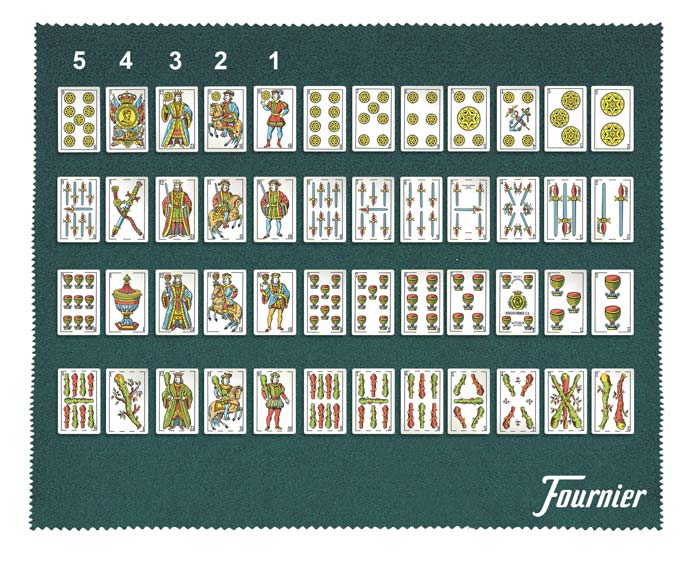Apparently Manilla originated in the Roussillon region and from there it spread through the south of France, where it is very popular, and through Spain, especially in Catalonia.
Win the point tricks needed to reach the sum of points established.
It is played with a 48 card Catalan deck.
It is played by four players who form two couples that play against each other.
EThe order, from highest to lowest, is: nine or Manilla, ace, king, knight, jack, eight, seven, six, five, four, three and deuce.
The value of the cards is given in the table below:
| Nine | 5 Points |
| Ace | 4 Points |
| King | 3 Points |
| Knight | 2 Points |
| Jack | 1 Point |
Each completed suit is worth 15 points The remaining cards, called Blancas, have no point value.
Each player turns over one card, the two players with the highest cards play against the other two. Whoever drew the highest card chooses where to sit and is the first to deal the cards, with their partner sitting in front of them and the opposing player who drew the highest card sitting on their right.
If two or more cards of equal value are drawn, preference is determined by the suit, in the following order: coins, cups, swords and clubs.
The dealer shuffles the cards and the deck is cut by the player on
the dealer’s left, the dealer then deals out twelve cards to each player, four by four, from left to right and the dealer’s last card is turned face up to determine the trump suit. If this card is worth points (Manilla or face cards), the dealer’s team score these points, except in a certain case which is explained later on. The stated order of rotation is also followed for the turn to deal and play.
The player to the right of the dealer starts the game, playing one card. The other players play in the stated order of rotation, observing the following rules.
If the opponent is winning the trick, then the rules are:
When the partner is winning, the only obligation is to follow the suit, if possible. They player is not required to play a trump card and can choose to play any scoring or non-scoring card.
A trick that does not contain trumps is won by the highest card of the suit played. A trick that does contain trumps is won by the highest trump card. The person who wins a trick, also wins the hand to start the next trick.
Capote is when one of the pairs of partners wins all twelve tricks. Capote has no special bonus, but it does win a hand or in other words, half the match.
A team wins a hand when it manages to score 40 points. There is the possibility that a pair can score this straight away, if they add 4 or 5 points from the initial trump card and deals Capote to the other team, which is normally done over several partial games.
The match is won by the pair that wins two hands. Any points above 40 in one hand do not carry over to the next, which starts with an initial score of 0 points for each pair.
A sheet of paper with a box for each pair of players is used to keep score.
The first points that are normally scored are the value of the initial trump card (if worth points), which correspond to the dealer’s team.
Each trick is worth one point for the team that wins it. The possible game score is 72 (60 points for the value cards among all the suits plus 12 points for twelve tricks). For each hand, only the team which, due to the tricks won, has more than 36 points scores, and only the points above 36 are noted on the sheet. If both teams have 36 points, then no score is counted (except for the initial trump card, if worth points) and a new hand is dealt.
When the dealer’s team has enough points to complete a hand with the value of the initial trump card, this value is not counted until the hand is played. If the dealer’s team gets at least 36 points, these are then added to the score and the hand finishes. However, if the dealer’ team gets fewer points than the other team, the latter scores the points that correspond to them and the former do not get the points from the initial trump card. And if the hand has not ended, the game continues.
Manilla for two players is played with cards shown. The basic rules are the same as in the Manilla for two couples, however, in this mode each player plays with 24 cards that are placed in six piles each containing 4 cards, where the top card is face up, revealing the next card as play progresses. The “hand” plays one of their upturned cards and the other player responds with one of theirs, with the obligation to:
The player who wins the trick starts the next hand.
Scoring in the game is similar to the other version, but with one slight difference:
The dealer scores from the initial trump card, if it is worth points. The points for the value cards in the tricks won are the same. The score for tricks is done by assigning one point to each four cards in the trick won.
As tricks are made with two cards, two things can happen:
Only the player that makes more than 36 points scores and only for the points in excess of 36.
If you wish to receive the latest news from Fournier in your email
Sign up!
Are you a distributor, collector, card fan, professional player? At Fournier we have the best exclusive information from within the sector, personalized to suit your interests.
Sign up!

